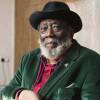Updated at 10:30 a.m. Nov. 12
This weekend, Boston’s Museum of Fine Arts will celebrate the opening of its new, state-of-the-art conservation center.
Visitors will be able to tour the center and speak directly with conservators who combine cutting-edge science with the latest historical research to preserve stunning works of art, from paintings and sculptures to functional objects like musical instruments and furniture.
It’s part of a bigger trend of museums engaging more directly with audiences.
“It is an opening up of the museum world,” said Yuqi Chock, the museum’s inaugural conservation fellow in community engagement. “We are understanding new ways to connect with our audiences and it really is for the better.”
Rhona MacBeth, the museum’s director of conservation and scientific research, has been involved in conservation here for nearly 30 years. In that time, she’s seen the museum’s approach toward conservation come a long way.
“It used to be a hidden, behind-the-curtain exercise,” she recalled. “Over the last decades through our conservation in action program, as we’ve brought it into the public, we’ve developed more programming — so not only can the public see us working, but they can have conversations with us.”
During opening week, visitors can sign up for free tours to get acquainted with this new 22,000-square-foot space and its six laboratories, as well as attend educational programs on conservation practices.

The spacious furniture and frames lab evokes images of a scientific laboratory or hospital, with imaging equipment and chemical bottles and artifacts laid out on the tables, like patients in their beds: old furniture, frames and even a cello. They also work with plastics and metals here.
But the real star of the room? That would be the giant, glorious 15th-century gilded Venetian altarpiece. Missing from it are a few small patches of gold and wood along with the nine paintings it framed, which are being restored separately.

This particular piece, which will be featured during the center’s opening week, showcases three different conservation areas: frame, painting and sculpture.
“Those are all traditionally treated by different conservation specialties,” MacBeth explained, “and so the fact that we are right next to each other means we can collaborate on a whole different level.”
In fact, the paintings laboratory is just a few steps away from where the altarpiece is being worked on. In the past, these conservationists would work in separate spaces with locked doors, MacBeth said — a stark contrast to this new design that offers ease of movement and collaboration.

Each of these laboratories contains overpowering beauty — and history — of the greatest art, in every medium imaginable, from every part of the world. Some pieces are thousands of years old.
Whatever kind of art appeals to you, MacBeth says there’s something at the conservation center you’ll appreciate.
“Object conservation, textiles, paper conservation — everyone is participating in the opening week,” Chock said.
The conservation center is open now. Tours and workshops will be available through Nov. 14.
Correction: This story was updated to correct the spelling of Yuqi Chock's name. We regret the error.








